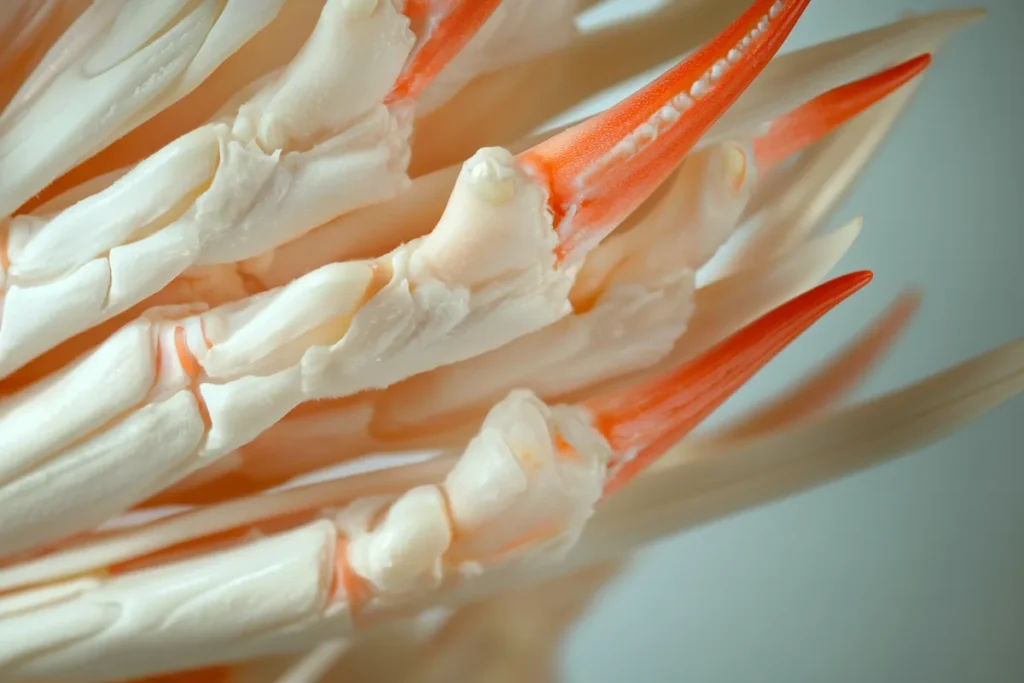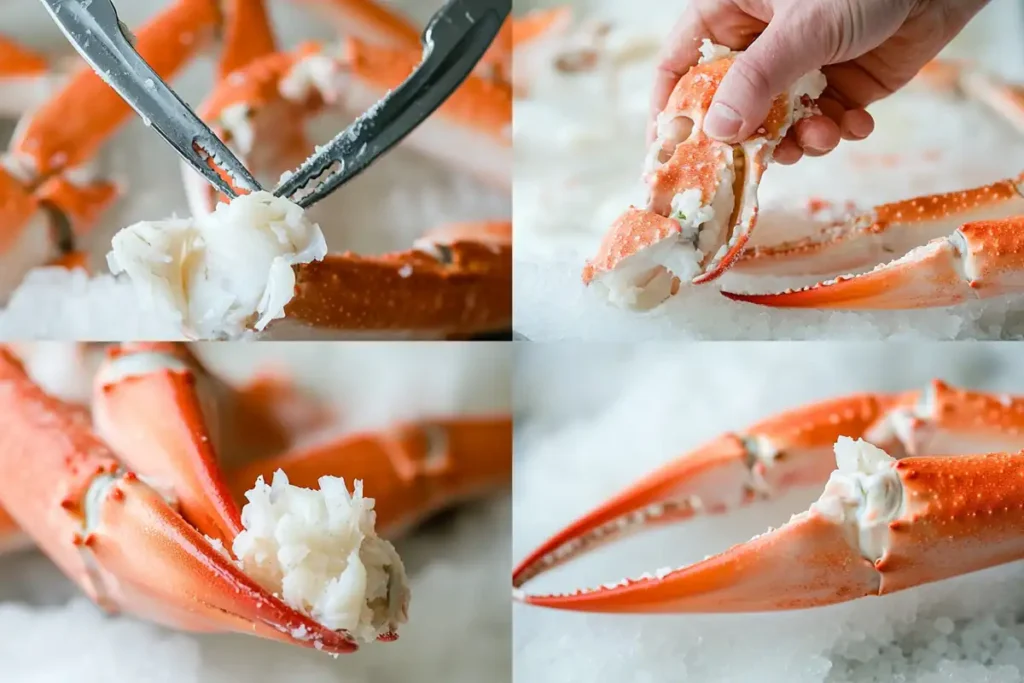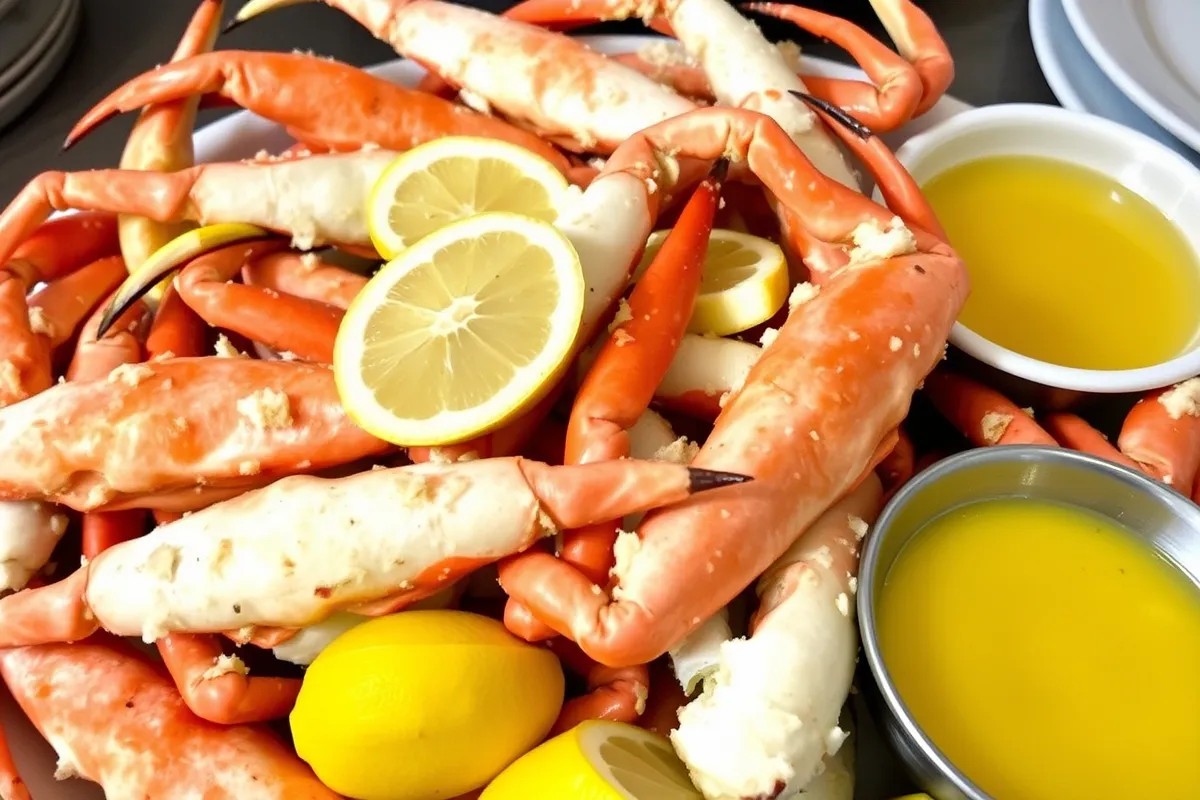Snow crab legs are one of the ocean’s finest delicacies. Whether you are hosting a seafood feast or planning a cozy dinner, snow crab claws bring a touch of luxury to your meal. With their delicate, slightly sweet flavor and tender texture, they are a favorite for many seafood lovers across the United States. In this ultimate guide, we’ll explore everything you need to know about snow crab claws, including cooking techniques, nutritional benefits, and the best ways to enjoy them.
What Are Snow Crab Legs?

Snow crab legs are the legs of the snow crab, a crustacean found in the cold waters of the North Atlantic and Pacific Oceans. These crabs are smaller than king crabs but make up for it with their incredibly flavorful and juicy meat. Snow crabs get their name due to their habitat—they thrive in cold, icy waters—and their whitish color when cooked, reminiscent of snow.
Snow crabs are harvested sustainably, making them an environmentally friendly choice for seafood lovers. According to NOAA Fisheries, snow crab populations are carefully managed to ensure the ecosystem remains balanced and healthy.
The snow crab’s slender, long legs are rich in sweet, succulent meat. Their shells are relatively soft compared to other crabs, making them easy to crack and eat without the need for heavy-duty tools. Cooking snow crab legs is a simple yet rewarding culinary experience.
How Many Legs Is 1 lb of Snow Crab Legs?
When you purchase snow crab claws, you’ll notice that they are typically sold in clusters. A cluster usually includes half of the crab’s body, along with four walking legs and one claw. Generally, 1 lb of snow crab claws contains two clusters, which means you’ll be getting around eight legs and two claws. The weight can vary depending on the size of the crab, but this is the average amount.
For a satisfying meal, it is recommended to serve between 1 to 2 pounds of snow crab legs per person. If you’re preparing them as part of a larger seafood spread, 1 pound per person is usually enough. Snow crab legs are quite versatile and pair beautifully with a variety of side dishes, such as buttered corn, garlic bread, or fresh salads.
Why Are They Called Snow Crabs?
The name “snow crab” comes from both their environment and appearance. They are found in the icy waters of the North Atlantic and Pacific, and when cooked, their shell turns a bright, snowy white color. The term “snow” reflects both their origin in cold regions and the distinctively pale hue of their cooked shell.
Snow crabs have adapted to survive in cold temperatures, which gives their meat its unique texture and flavor. Their legs are slender but packed with meat, which has a slightly sweet taste that differentiates it from other crabs. Snow crabs are an excellent choice for those who appreciate a more delicate crab flavor, compared to the more robust king crab.
How to Cook Snow Crab Legs
Cooking snow crab clawssnow crab legs is easier than you might think. Whether you’re an experienced cook or a beginner in the kitchen, you’ll find that snow crab claws are quick to prepare and hard to mess up. Below are some of the best methods for cooking snow crab claws:
1. Boiling
Boiling is one of the simplest and most popular ways to cook snow crab clawssnow crab legs. Here’s how you do it:
- Bring a large pot of water to a boil. You can add salt to the water for extra flavor.
- Place the snow crab clawssnow crab legs in the pot and make sure they are fully submerged.
- Boil the legs for about 4-5 minutes. If they were frozen, add an extra minute.
- Drain the water and serve the crab legs hot with melted butter and lemon wedges.
2. Steaming
Steaming snow crab claws helps to retain their delicate flavor and moisture.
- Add a few inches of water to a large pot, and place a steamer basket on top.
- Bring the water to a boil.
- Place the crab legs in the steamer basket and cover.
- Steam for 5-6 minutes, until heated through.
- Serve with melted garlic butter and fresh herbs.
3. Baking
If you prefer an oven-baked version, baking snow crab claws is another great option.
- Preheat your oven to 350°F (175°C).
- Arrange the crab legs in a baking dish and add a little water to create steam.
- Cover with aluminum foil and bake for 15-20 minutes.
- Serve with your favorite dipping sauce.
4. Grilling
Grilling snow crab legs adds a smoky flavor that pairs perfectly with the natural sweetness of the meat.
- Preheat your grill to medium heat.
- Brush the crab legs with olive oil to prevent sticking.
- Grill the legs for about 5-7 minutes, turning occasionally.
- Serve with a zesty lemon butter sauce.
Best Dipping Sauces for Snow Crab Legs
The right dipping sauce can elevate your snow crab claws to a whole new level. Here are some of the best dipping sauces to try:
- Classic Garlic Butter Sauce: Melted butter with minced garlic and a splash of lemon juice.
- Spicy Sriracha Mayo: Mix mayonnaise with sriracha, a touch of honey, and a squeeze of lime.
- Herbed Lemon Butter: Melted butter with fresh herbs like parsley and dill, plus lemon zest.
- Mustard Aioli: A tangy blend of mayonnaise, Dijon mustard, garlic, and lemon juice.
Nutritional Benefits of Snow Crab Legs
Snow crab legs are not only delicious but also packed with nutrition. They are a great source of protein, which helps in muscle growth and repair. They are also low in fat and calories, making them an ideal choice for a healthy diet.
Additionally, snow crab clawssnow crab legs are rich in essential vitamins and minerals, including:
- Vitamin B12: Crucial for nerve health and red blood cell production.
- Zinc: Supports immune function and wound healing.
- Selenium: Acts as a powerful antioxidant, protecting cells from damage.
Compared to other seafood, snow crab claws are relatively low in mercury, making them a safer option for regular consumption. According to Seafood Watch, snow crabs are a sustainable choice, as they are harvested in a way that minimizes the impact on ocean ecosystems.
Which Crab Is Best to Eat? Snow Crab vs. King Crab
When it comes to choosing the best crab to eat, it often comes down to personal preference. Both snow crab legs and king crab legs have their own unique characteristics:
- Snow Crab Legs: Smaller, more delicate, and slightly sweet. The meat is tender and easy to extract, making snow crab claws ideal for those who prefer a milder taste.
- King Crab Legs: Larger and meatier, with a richer flavor. King crab legs are often more expensive, but they are perfect for those who want a bold, decadent crab experience.
Ultimately, if you enjoy a subtle, sweet flavor and are looking for an affordable option, snow crab legs are the way to go. However, if you want something extravagant and are willing to spend a bit more, king crab may be worth trying.
Tips for Buying Snow Crab Legs
When buying snow crab legs, there are a few things to keep in mind to ensure you get the best quality:
- Frozen vs. Fresh: Most ssnow crab claws now crab legs available in the U.S. are pre-cooked and frozen. This is because they are caught far from shore and need to be processed immediately. Buying frozen crab legs is perfectly fine—just make sure they are not thawed and refrozen, as this can affect the quality.
- Color: Look for bright, white shells with hints of red or orange. The meat should appear translucent, with no gray or dark spots.
- Smell: The crab legs should have a mild, ocean-like smell. If they smell overly fishy or sour, it’s best to avoid them.
How to Serve Snow Crab Legs
snow crab claws are perfect for any occasion—whether it’s a backyard cookout, a family dinner, or a special celebration. Here are some ideas for serving them:
- Seafood Boil: Create a classic seafood boil by pairing snow crab claws with shrimp, corn on the cob, potatoes, and sausage.
- Surf and Turf: Serve the crab legs alongside a juicy steak for an indulgent surf and turf meal.
- Pasta: Toss the crab meat with linguine, garlic, olive oil, and a touch of white wine for an elegant pasta dish.
- Salad: Add the crab meat to a fresh salad with avocado, cherry tomatoes, and a light vinaigrette for a healthy lunch.
How to Properly Crack Snow Crab Legs
Cracking snow crab claws may seem daunting at first, but with the right techniques, you’ll be able to enjoy every delicious bite. Here’s how to do it:
1. Gather Your Tools
Before you start, gather a few simple tools:
- Seafood Cracker or Nutcracker: This will help you crack the harder parts of the shell.
- Seafood Picks or Forks: These are useful for extracting the meat from the shell.
- Scissors: Kitchen shears are ideal for cutting through the softer parts of the shell.
2. Break at the Joints
Start by breaking the legs at the joints. Hold the leg with both hands and gently bend it until it snaps. This will give you smaller pieces to work with, making it easier to extract the meat.
3. Use Scissors for Easy Access
Take a pair of kitchen scissors and cut along the length of the shell. Start from the thicker end and cut all the way down. This will expose the meat, allowing you to pull it out easily.
4. Use a Seafood Pick
If there is any meat left in the smaller sections, use a seafood pick to extract it. These small tools are perfect for reaching into the nooks and crannies of the crab leg.
Common Mistakes to Avoid When Cooking Snow Crab Legs
While cooking snow crab clawsis straightforward, there are a few common mistakes that can lead to less-than-perfect results. Here are some mistakes to avoid:
1. Overcooking the Crab Legs
One of the most common mistakes is overcooking the crab legs. Remember, most snow crab legs are pre-cooked before they are frozen, so you only need to reheat them. Overcooking can make the meat tough and rubbery. Stick to the recommended cooking times to ensure the crab stays tender and juicy.
2. Not Adding Enough Flavor
Snow crab legs have a naturally sweet flavor, but they can benefit from a little extra seasoning. Adding salt to the boiling water, or using flavored butter for dipping, can enhance the overall taste of the crab.
3. Using the Wrong Tools
Trying to crack crab legs without the right tools can be frustrating and messy. Invest in a good seafood cracker and picks to make the process much easier and more enjoyable.
Health Benefits of Snow Crab Legs
Eating snow crab legs isn’t just a tasty experience; it also comes with a range of health benefits. Here are some reasons why snow crab claws are a great addition to your diet:
1. High in Protein
Protein is essential for building and repairing tissues, and snow crab legs are an excellent source of lean protein. A 3-ounce serving of snow crab claws contains approximately 15-20 grams of protein, making it a great choice for anyone looking to increase their protein intake.
2. Low in Fat and Calories
For those watching their calorie intake, snow crab legs are a smart choice. They are naturally low in fat and calories, making them a healthier option compared to many other types of meat. A serving of snow crab claws contains around 100 calories, which makes it easy to incorporate into a balanced diet.
3. Rich in Omega-3 Fatty Acids
Snow crab legs contain omega-3 fatty acids, which are known for their heart health benefits. Omega-3s help to reduce inflammation, lower blood pressure, and improve overall cardiovascular health. Including seafood like snow crab legs in your diet can contribute to a healthier heart.
4. Packed with Essential Vitamins and Minerals
Snow crab legs are rich in vitamins and minerals, including vitamin B12, zinc, magnesium, and selenium. Vitamin B12 is important for maintaining nerve health and energy levels, while selenium acts as an antioxidant, protecting the body from oxidative stress.
Delicious Side Dishes to Serve with Snow Crab Legs
To create a truly memorable meal, pair your snow crab legs with delicious side dishes. Here are some of the best side dishes to serve with snow crab legs:
1. Garlic Butter Rice
A simple garlic butter rice is the perfect complement to the rich flavor of snow crab legs. Cook some long-grain rice and mix in garlic, butter, and fresh herbs for a flavorful side dish.
2. Corn on the Cob
Corn on the cob is a classic side dish for any seafood feast. Boil or grill the corn, and slather it with butter, salt, and a sprinkle of paprika for added flavor.
3. Roasted Vegetables
Roasted vegetables, such as asparagus, bell peppers, and carrots, add color and nutrition to your meal. The slight caramelization from roasting enhances their natural sweetness, making them a great match for the sweet meat of snow crab legs.
4. Caesar Salad
A crisp Caesar salad is a refreshing addition to a seafood meal. The creamy dressing, crunchy croutons, and fresh Romaine lettuce provide a nice contrast to the tender crab meat.
5. Baked Potatoes
Baked potatoes are another classic choice that pairs well with snow crab legs. Top them with sour cream, chives, and a bit of cheese for a comforting side dish.
Creative Ways to Use Leftover Snow Crab Meat

If you happen to have any leftover snow crab meat, don’t let it go to waste. There are plenty of creative ways to use it in other dishes:
1. Crab Cakes
Turn your leftover crab meat into delicious crab cakes. Mix the crab with breadcrumbs, egg, mayonnaise, mustard, and seasonings, then form into patties and fry until golden brown. Crab cakes make a fantastic appetizer or main course.
2. Seafood Tacos
Use your leftover crab meat to create seafood tacos. Warm up some soft tortillas, and fill them with crab meat, shredded cabbage, avocado, and a drizzle of lime crema. These tacos are light, flavorful, and perfect for a quick lunch.
3. Crab-Stuffed Mushrooms
Stuff large mushroom caps with a mixture of crab meat, cream cheese, garlic, and breadcrumbs, then bake until golden and bubbly. Crab-stuffed mushrooms make an elegant appetizer for any occasion.
4. Crab Salad
Make a light and refreshing crab salad by mixing the crab meat with chopped celery, red onion, mayonnaise, and a squeeze of lemon juice. Serve it on a bed of lettuce or use it as a filling for a sandwich or wrap.

